► The bulky boys are in town for this premium 4×4 giant test
► Audi Q7 takes on Lexus and Volvo for the SUV crown
► Three cars with very different takes on the lux off-roader brief
At the big end of the premium SUV market here’s the heat. Three fresh-faced bar-raisers trade drivetrains, design schools and tech solutions in their heartland territory: the city…
Electric windows. Nothing new. But the ones on the latest Lexus RX450h are astonishingly quiet, zipping up and down with silk-like smoothness as if someone has put the audio on mute. It’s surprisingly impressive, to the point that it makes you stop to think: if the engineers put this much effort into something that some owners might never even notice, then how seriously must they have taken the rest of this car? It’s a thought that the typical ‘Lexus lowing’ propagated by the hybrid system’s Continuously Variable Transmission almost immediately undermines. But it’s also a thought that sticks in the back of your brain, like Spiderman in a glue factory.
Even so, the first thing to strike you about the new RX450h is that Toyota/Lexus doesn’t seem to have moved the mechanical game on since it first introduced the hybrid concept with the original Prius; the original protagonists are apparently stuck in the pre plug-in era, which in RX terms means a seemingly profligate 3.5-litre naturally aspirated V6 petrol combined with a tiny battery pack that delivers electric running at no more than a mile at a time. Although, actually, that’s a lie, because the first thing that really strikes you about the new RX is the way it looks.
There is no ignoring this car. From the enormous ‘spindle’ grille to the exaggerated crease lines, planed-off wheelarches and extended overhangs, the RX is making a hell of a statement – and although exactly what it’s supposed to be saying isn’t necessarily clear, it’s certainly good at attracting attention. People quite literally stop and stare, and while this patently isn’t always in appreciation, there is still an aura of considered discernment. It’s an alternative choice, but also obviously premium.
But wait. The new RX is hardly the only interesting entrant in the moderately massive premium SUV market right now. If you want to stand away from the German crowd, the second generation Volvo XC90 has got enough Scandinavian cool to fill a furniture warehouse. And this one isn’t just flexing the R Design specification, complete with athletically enhanced aesthetics, it’s a T8 Twin Engine – Volvo’s latest hybrid with a plug socket. Meaning that unlike the Chino-Swedes’ premier plug-in guinea pig, the lacklustre diesel-engined V60, this XC90 pairs a theoretical 26-mile EV range with a 2.0-litre four-pot petrol boosted by both supercharger and turbo. Will this extended electric capability and downsized forced induction wizardry underline just how out of touch the RX has become?
From the outside at least, the XC90 is a much more conventional take on the modern SUV: muscular, upright and, with its short overhangs, decidedly pert. A handsome beast, then, with strong shoulders and those ‘Thor’s Hammer’ daytime running lights adding a distinctive steely stare. This is a car that exudes culture and taste, even when it’s finished in fire engine ‘Passion Red’ like Postman Pat’s off-road knocking shop – and even discounting the promise of intelligent solutions inside and under the bonnet, the glances it attracts are all admiration and envy.
Would the same ever be said of the Mk2 Audi Q7? I kind of doubt it. As with the most recent BMW X5, it’s almost as if its makers have reacted to the obnoxious in-yer-face appearance of the predecessor by making it look so boring it seems to be ashamed of itself. Gone are the big bold SUV lines, replaced by plain flanks, demure details and the overall look of a supersized estate car. This one’s a supposedly sporty S line, and it’s got nothing alluring about it on the outside at all. But perhaps you’re the sort who wants life to pass by without comment. And given how enormous it is – easily the biggest contender here – really that’s quite a neat trick.
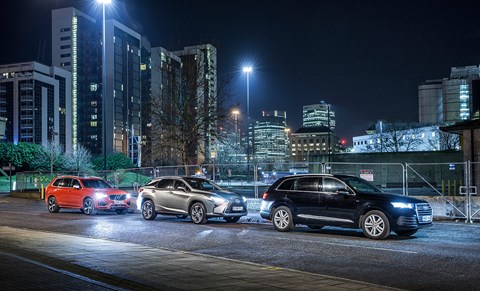
There is a plug-in hybrid Q7 e-tron quattro coming, but to fully test the new RX450h’s mettle we’ve brought along that arch rival to all hybrids everywhere: a German diesel. In this instance it’s a 3.0-litre V6, complete with AdBlue after treatment system to minimise the nasty NOx emissions. Not only is this a super-smooth choice, the lack of battery packs, electric motors and other associated gubbins means it’s the lightest of our trio (if by only 40kg over the Lexus). This ought to help it make a bigger impression on the road.
So, we have one hybrid, one plug-in hybrid and one diesel. And while power output ranges from 268bhp to 401bhp, as tested they’re within £5000 of each other. None of them have any real pretence of off-road ability. Rather, these are modern lifestyle cocoons, packed with neat little gadgets and seating you high enough to both feel secure and actually be able to look down on the rest of the world.
On the road
Driven in isolation, the Lexus acquits itself with calm assurance. While 0-62mph in 7.7sec makes it the slowest of our trio, a combined 308bhp and the ever-present insta-torque assistance of the front and rear electric motors means it steps off smartly and responds with determined alacrity when called upon to overtake. F Sport and Premium versions come with adaptive suspension and a Sport+ driving mode (on top of Eco, Sport and Normal), which does a decent job of contradicting your preconceived notions about constantly variable transmissions.
Though a hint of the powerboat always remains – a sudden flare of revs and the sensation that the nose is pointing decidedly more skywards – there is less of that old drunken slurring as the gearbox races to put the engine into the heart of its power band. It’s now more of a step-change, like a finger snap or a switch flip, engendering a far greater impression of precision. A new ‘sound generator’ flatters your experience of the V6 in the cabin, too.
Push hard cross-country and you’ll find that, of the three, the Lexus is earliest to give in to understeer. But it does so with reasonable grace, the front end delivering plenty of warning before it starts to wash wide; the steering is nicely weighted for all that it lacks feel, and when set to Sport+ the suspension gamely resists rolling while retaining plenty of composure. Mostly, however, you’re content to waft along, rarely feeling the need to extend the RX’s performance. Even without the Volvo’s prolonged electric capability, the green EV light in the gauge cluster appears with satisfying regularity, as the quick give and take of the Lexus hybrid system allows it to recuperate with as much ease as it discharges. The transition between motive forces is seamless.
The Audi is easily the sharpest tool. With 268bhp it may be the least potent on test, but 0-62mph in 6.5sec will give plenty of hot hatches reason to reconsider and the turbocharger ushers in 442lb ft at just 1500rpm. It’s instantly more urgent than the Lexus, sending you surging out of roundabouts with almost unseemly vigour and revving right out to the redline – to the tune of a refined growl that’s barely perceptible over the yelps from your three rows of passengers.
Its eight-speed auto is a bit of a quandary. You’re never granted complete control over the upshifts, and even in the Dynamic driving setting it’s so smooth you sometimes find it’s sneaked into a higher gear – sounds great until you pull out for an overtake and discover you haven’t got the oomph you were expecting. Left to its own devices around town, it often leaves you hanging before deciding to downshift, usually when you want to make that crucial gap in the traffic.
There’s a similar set of swings and roundabouts about the chassis, which is at once impressively quick-witted for a car of this size – especially the way the front end is so keen to tuck into corners – but also more likely to get you into trouble, insinuating an agility the Q7 doesn’t always prove able to deliver. The ride quality is also this group’s most fractious, if rarely intolerably uncomfortable.
The Volvo sits between the two – more tenacious than the Lexus, less outright eager than the Audi. This particular car is on the standard steel suspension rather than the optional air, which means it makes more of a meal of sudden surface disruptions, battering its way along rougher roads instead of attempting to appease them. In exchange you get less of the continuous high frequency chop that plagues air springs, so it depends what’s going to irk you more; I’d be inclined to stick to steel but some prefer the air’s greater cushiness and choice of settings. Regardless, this Volvo is still closer to the Lexus than the Audi when it comes to comfort.
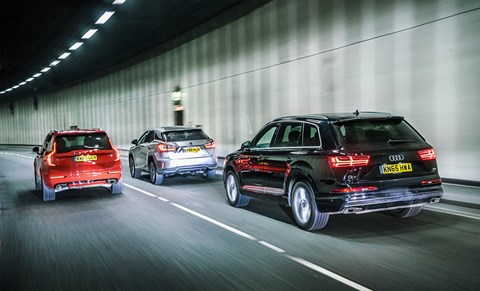
In performance terms, the T8 approaches monster. The 316bhp 2.0-litre twin-charged petrol alone produces more power than either rival, so despite the 2343kg kerbweight you never need to fear it feeling lethargic when you’ve depleted the batteries or set the system to Save to preserve them. Activate the Power mode or whack the throttle to the floor and the combined 401bhp output is enough to see off 0-62mph in 5.6sec, which will firmly plant the doggie in the window whenever the RSPCA isn’t looking. At this point you might just wish for a touch more of the Audi’s directional incisiveness, but the XC90 handles itself with all the confidence the exterior proclaims.
There are some curiosities. Despite its promise, the Save mode doesn’t entirely prevent the batteries from being depleted, so don’t wait too long to make use of the hours you’ve devoted to the National Grid. The engine sounds a little too much like a building site generator at idle, and partway through our test the drivetrain developed a mysterious low-speed shudder when pulling away from speed bumps. And though the manner in which we picked up an eighth of a battery charge from brake energy regeneration alone during a 20-minute B-road strop suggests you’ll be rewarded for driving hard, our overall 21.7mpg (including fast motorway and a lot of late-night photography in London) says you need to be more considered.
In the cabin
On the inside you’ll either be wowed by Volvo’s touchscreen solution or irritated. No denying the pacifying effect of the resulting dashboard declutter, but the interface isn’t overly intuitive and for all that it looks exciting there are times when you just want to be able to reach out and twist a knob in order to adjust the climate control. Not that the other two allow you this luxury, either; when it comes to ease of use you may be swayed by confidence in your touchscreen dexterity versus your lower-centre-console-button-finding radar.
Elsewhere in the Volvo it’s lots of lovely leather, clean lines, a thumping £3000 Bowers & Wilkins hi-fi and a really nice set of R Design front seats in this instance. Very modern, very calming – even if the T8’s light-up Orrefors crystal gearknob has the aura of an intimate accessory for exhibitionists. Despite the need to find room for the batteries, like the Audi it still offers space on board for seven; the XC90’s design cunningly incorporates all 9.2kWh of current capacity within the area a conventional 4×4 would reserve for the propshaft – the Volvo’s rear wheels are turned by the electric motor exclusively.
Inside the Lexus couldn’t be more different. Just the five seats (admittedly with plenty of room in the back), but more than that, a riot of layered leathers, red contrast stitching, wood veneer and buttons. Not to mention that funny mousy infotainment controller, which takes some getting used to. The really crazy part, however, is that the more time you spend within this overblown luxury haberdashery, the more you come to appreciate it. The quality of everything from the feel of the volume knob – manipulating a wonderfully warm Mark Levinson hi-fi as standard on Premium spec – to the occasional harder plastic is almost unimpeachable. The increasing novelty of having individual switches for individual functions only serves to prove how well this strategy works when successfully laid out.
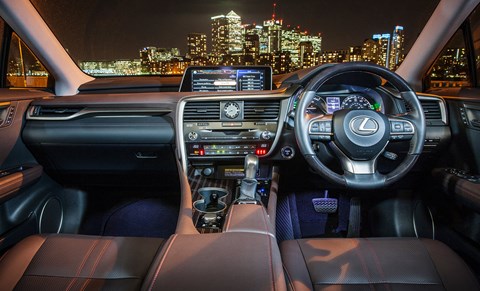
I’m usually anti-wood in any car, but the curve of the Riva speedboat-style inlay on the centre console is just gorgeous, and I love the analogue way the dials change priority depending on driving mode using nothing more than artfully disguised illumination. Add in the massive 12.3-inch widescreen display on the dash-top, the sheer scale of which serves to ease the pain of the undeniably erratic mouse controller, and the general passenger reaction is ‘wow!’ Okay, so the map graphics look more Ordnance Survey than Google (this despite access to Google Street View via a menu), the lack of full postcode address entry is baffling, and displaying the warning label next to the wireless phone charging pad like a badge of pride seems a strange decision, but overall the impression is finessed craftsmanship. Best of all, it makes you feel special.
By comparison the Q7’s interior just seems miserly, as if Audi ejected its customary elegance alongside the conventional gauge cluster; the digital ‘virtual cockpit’ display that replaces this as part of the £1950 Technology Pack is a fine – if increasingly familiar – party piece, but its companion central screen looks like a tiny apologetic afterthought in this company. Still, the giant touchpad lurking ahead of the gear selector has the best handwriting recognition system I’ve yet used in a car (either that or I’m getting better at scrawling letters with my left index finger), and the predictive nature of the sat-nav entry process is fantastic. Meaning that inside the Q7 is highly functional, well made and cavernous, but like the outside, bemusingly bland – the token effort of the ambient lighting notwithstanding.
Verdict
The Audi is by no means a bad car, but there’s just not really anything about it that makes me want to give it an overwhelming recommendation. While you can certainly make a case for it driving the best, that’s not really what these vehicles are about – and besides, the others are hardly shoddy from behind the helm themselves. The Q7 is not in contention for victory. The XC90, however, is undoubtedly one of the cars of the moment, and its revitalisation of the Volvo brand is deserving of every plaudit. The confident styling, the innovative interior and now the clever, tax efficient yet hugely powerful T8 drivetrain all make a great case for a worthy winner.
But I find myself drawn to the Lexus. The interior is individual, exceptionally high quality and – once you acclimatise – remarkably pragmatic; it provides comfort without sloppiness, goes as quickly as most will ever require, and I like seeing that little EV light come on, no matter how short the periods. The styling is divisive, and it won’t be for everyone, but the RX450h is – surprisingly – the SUV from this trio I’d most like to put on my drive.
Results
1st) Lexus RX: Put those eyebrows down – this is a hard-earned victory. Lexus has built a beautiful cabin and dressed it in an outrageous suit. Hybrid drivetrain not shamed here.
2nd) Volvo XC90: Everybody’s talking about the XC90, and this power-packed plug-in moves it on further. Only a Rizla paper separates it from the RX.
3rd) Audi Q7: The Q7 was always a conundrum and still is. Lacks charisma inside and out. Rich engine and conversation-piece clocks aren’t quite enough.
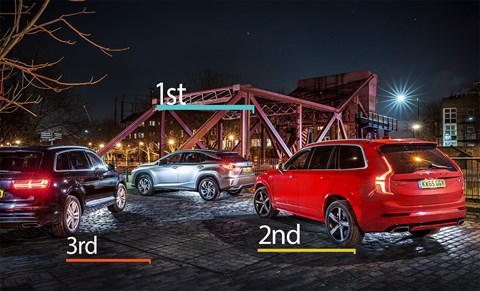
Key tech
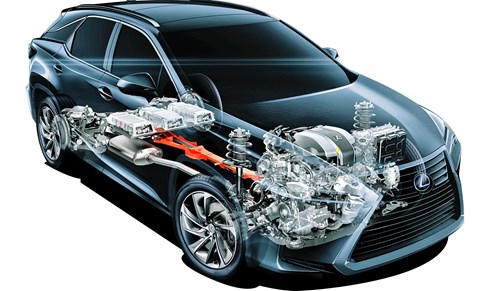
RX450h: Power of three
The hybrid system in the RX450h uses not one but two electric motors: a 68bhp/103lb ft 50kW item on the front axle and a 165bhp/247lb ft 123kW item on the back axle – that’s as much torque again as the V6 acting directly on the rear wheels. No wonder the mid-range acceleration is so strong. Just imagine what Lexus could do if it wasn’t using old-tech nickel metal-hydride batteries…
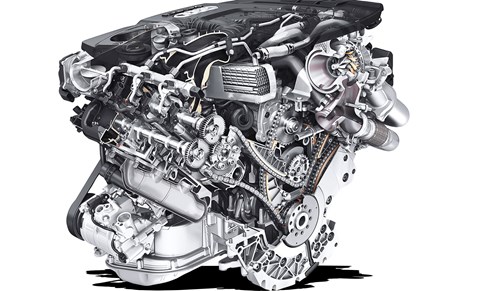
Q7: Six still the best
Audi’s keen to keep on building its smooth six-cylinder engines, even when faced with increasingly stringent emissions regulations, so it’s working hard to make sure they remain competitively efficient. The forthcoming 3.0 TDI E-tron Quattro ought to help, as it uses the same 268bhp 3.0-litre turbodiesel as our test car in combination with a plug-in hybrid system that claims a 35-mile electric range.
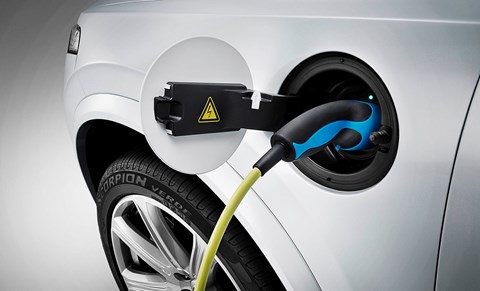
XC90 T8: The plug-in factor
Plug the T8 into a household socket and it’ll take about seven hours to recharge the 113kg li-ion battery pack that you need to use in order maximise efficiency. To make the most of that effort, Volvo gives you a choice of four driving modes: Pure, Hybrid, Power and Save. Use Save to keep the batteries for later use in EV mode around town, Hybrid in general and Power to teach sports cars a lesson.
Read more CAR comparison tests